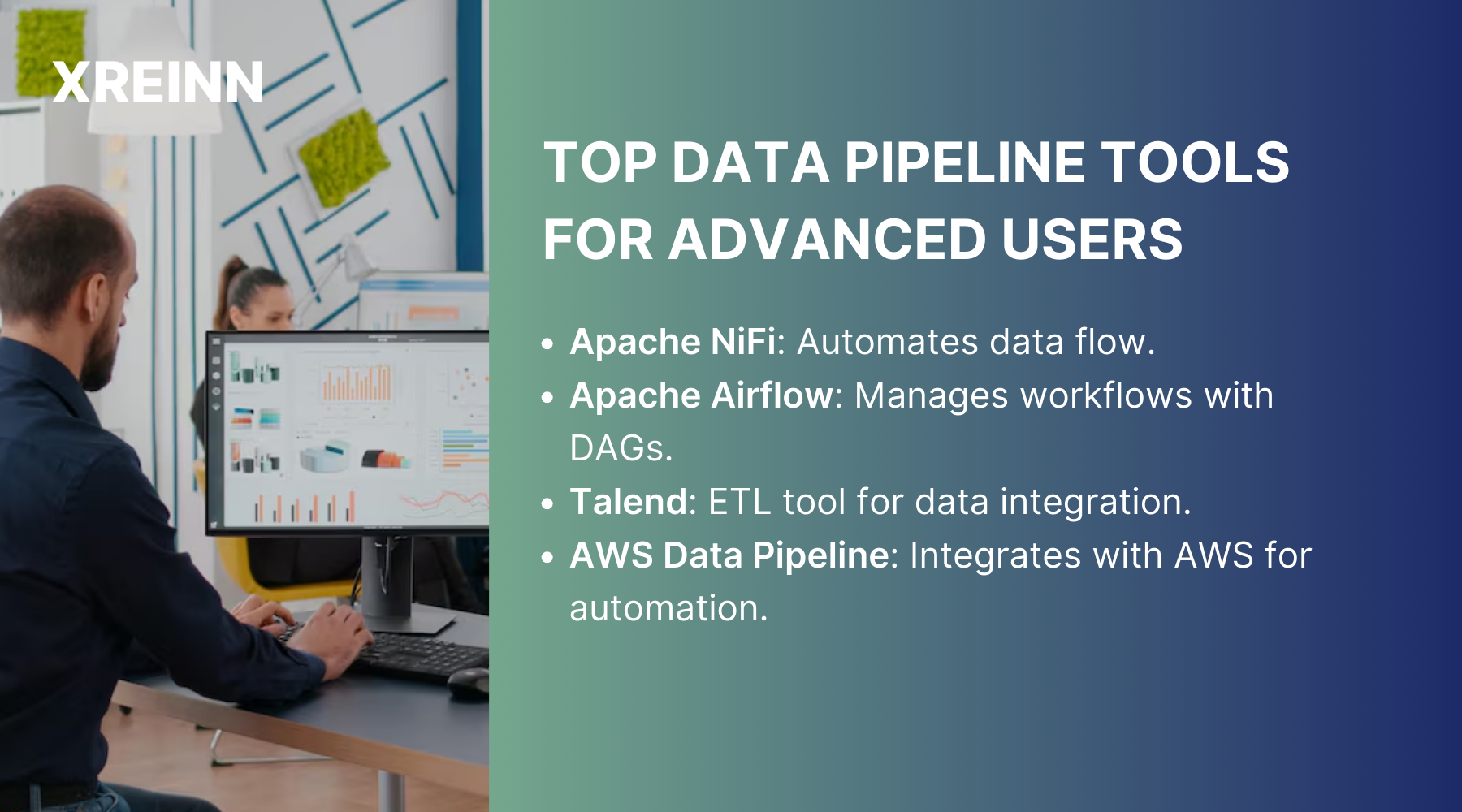Data Integration
How to Build Efficient Data Pipelines for Your Business?
Jul 24, 2024
Building efficient data pipelines is essential for any data-driven business. The process involves choosing the right tools, mastering management techniques, and using automation to streamline workflows. Without an optimized pipeline, data processing can be slow and prone to errors, which hinders decision-making and growth.
By focusing on advanced strategies, you can turn raw data into valuable insights that drive smart business decisions. This guide will show you how to enhance your data processes, reduce manual errors, and improve speed and accuracy.
Understanding Data Pipelines
Data pipelines are a series of processes that automate the collection, processing, and storage of data from various sources. Efficient data pipelines ensure that data flows seamlessly from its origin to its final destination, enabling accurate processing, transformation, and storage. They consist of several stages, including data ingestion, where data is collected from various sources; data processing, where data is cleaned, transformed, and enriched; and data storage, where data is securely stored for future use.
Effective data pipelines incorporate mechanisms for error handling, monitoring, and maintenance to ensure reliability and performance. This powerful framework is essential for integrating diverse data sources, supporting advanced analytics, and maintaining a scalable and efficient data infrastructure.
Components of a Data Pipeline
To build a sophisticated data pipeline, you need to understand its core components:
1. Data Sources and Ingestion Methods: Use APIs, web scraping, and database connections to gather data from multiple sources. Implement batch and real-time ingestion methods based on your specific needs.
2. Data Transformation and Processing: Employ ETL (Extract, Transform, Load) processes to cleanse, normalize, and enrich data. Use frameworks like Apache Spark or Apache Beam for large-scale data processing.
3. Data Storage and Retrieval: Opt for scalable storage solutions like Amazon S3, Google Cloud Storage, or HDFS. Implement efficient indexing and querying mechanisms to facilitate quick data retrieval.
Selecting the Right Data Pipeline Tools
When deciding which tools to use, consider a few key factors. Firstly, think about scalability; the tool should be capable of handling increasing data volumes as your business grows. Flexibility is also important, so look for tools that support various data sources and formats.
Integration capabilities are important as well; ensure the tools you select can seamlessly integrate with your existing infrastructure. Lastly, evaluate the cost-effectiveness of each option, considering not only the initial purchase price but also ongoing licensing and maintenance fees.
Top Data Pipeline Tools for Advanced Users

Apache NiFi: This tool is best for automating data flow between systems. Set up data flow templates, configure processors, and monitor data lineage for end-to-end traceability.
Apache Airflow: Ideal for performing complex workflows, Airflow allows you to define DAGs (Directed Acyclic Graphs) to manage task dependencies. Use Airflow’s scheduling and monitoring capabilities to ensure reliable data processing.
Talend: Known for its powerful ETL features, Talend provides a comprehensive suite for data integration. Configure advanced data transformations, error handling, and job execution monitoring.
AWS Data Pipeline: Seamlessly integrates with AWS services to automate data movement and transformation. Optimize pipeline performance by leveraging AWS’s scalable infrastructure.
Advanced-Data Pipeline Management
Managing data pipelines effectively ensures seamless data flow and high-quality outputs. Focus on optimizing workflows, monitoring performance, and maintaining data quality.
Data Workflow Optimization
To optimize your data workflows, start by identifying bottlenecks. Use profiling tools like Apache Spark's built-in tools to pinpoint slow stages in your pipeline, then optimize code, parallelize tasks, and allocate adequate resources to improve performance.
Implement parallel processing by distributing the workload across multiple nodes using frameworks such as Apache Spark, which reduces processing time and enhances throughput. Additionally, automate scaling by using auto-scaling features available in cloud platforms like AWS or Google Cloud to dynamically adjust resources based on workload demands.
Monitoring and Maintenance
Continuous monitoring and proactive maintenance are vital for pipeline health. Implement monitoring tools like Prometheus and Grafana to track pipeline performance in real-time, and set up alerts for anomalies and performance degradation.
Additionally, schedule regular maintenance tasks such as data validation, log analysis, and resource optimization to prevent issues before they escalate.
Data Quality Management
Maintaining high data quality is important for reliable insights. To ensure data accuracy and consistency, implement validation rules and checks at various stages of the pipeline and use data profiling tools to detect and correct anomalies.
Advanced data validation can be achieved by using machine learning models to predict data quality issues and automate corrective actions. Additionally, integrate data quality checks into your CI/CD pipeline for continuous assurance.
Automating Data Pipelines
Automation reduces manual intervention, increases efficiency, and ensures data consistency. Automating your data pipelines enhances efficiency by automating repetitive tasks, freeing up resources for strategic initiatives. It improves consistency by reducing human errors and ensuring data is processed uniformly. Additionally, automation facilitates scalability, making it easy to scale automated processes to handle larger data volumes.
Tools for Pipeline Automation
Use these tools to automate your data pipelines:
1. Prefect: Automate workflow orchestration with Prefect’s dynamic scheduling and error-handling features. Define complex workflows as code, ensuring reproducibility and scalability.
2. Dagster: Integrate Dagster for pipeline monitoring and lineage tracking. Its modular architecture allows for flexible deployment and management.
3. Jenkins: Use Jenkins for continuous integration and deployment of your data pipelines. Automate testing, deployment, and monitoring to ensure the best pipeline performance.
Implementing Continuous Integration and Continuous Deployment (CI/CD)
Implementing CI/CD in your data pipelines involves several essential steps. First, establish version control with Git to ensure all changes are meticulously tracked and auditable. Next, automate testing by integrating unit, integration, and end-to-end tests into your CI/CD pipeline, allowing you to identify and resolve issues early.
Finally, ensure seamless deployment by using tools like Jenkins or GitLab CI/CD to automate the deployment process, guaranteeing that changes are deployed consistently and reliably.
Security and Compliance in Data Pipelines
Ensuring the security and compliance of your data pipelines is essential for protecting sensitive information and adhering to regulations. To secure your data pipelines, implement several best practices. Use encryption for data at rest and in transit, and implement SSL/TLS for secure data transmission.
Employ role-based access control (RBAC) to limit access to sensitive data and use IAM (Identity and Access Management) policies to enforce security policies. Additionally, use VPNs or private networks for data transmission and implement network segmentation to isolate critical data flows.
Conclusion
Building efficient data pipelines necessitates a comprehensive grasp of advanced tools, management strategies, and automation techniques. Optimize your data workflows, ensure high data quality, and maintain a competitive edge by continually innovating and adapting to emerging trends. This approach will help you sustain a robust and efficient data infrastructure.

Data Analytics
Jun 27, 2024Master key concepts in data analytics with practical tips to enhance decision-making and achieve success in your projects and professional growth

Data Analytics
Jul 01, 2024Learn the essential stages of the data analytics workflow to turn your data into valuable business insights and drive growth.

